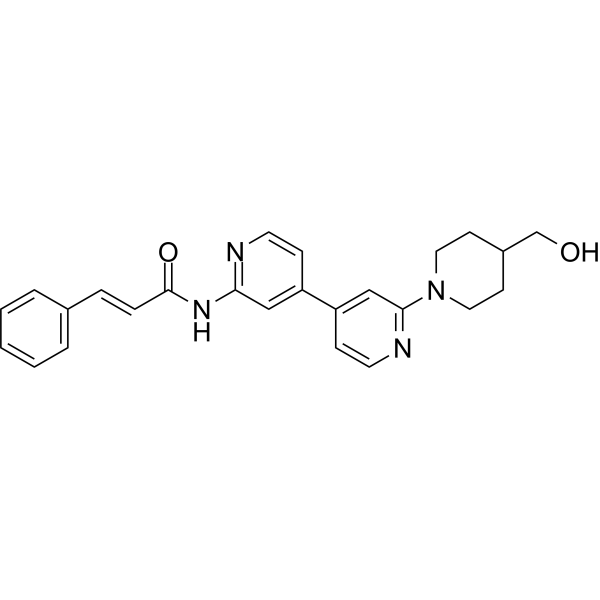
| 规格 | 价格 | ||
|---|---|---|---|
| 500mg | |||
| 1g | |||
| Other Sizes |
| 靶点 |
PARP Bcl-2 Mcl-1
|
|---|---|
| 体外研究 (In Vitro) |
在 MDA-MB-231 细胞中,BPA-B9(0-250 nM,24 小时)会导致细胞凋亡 [1]。 A549 细胞周期的 G2/M 期受 BPA-B9(0-125 nM,12 小时)抑制 [1]。 BPA-B9(0-500 nM,0-24 小时)会导致裂解的 PARP 表达呈剂量和时间依赖性上升,以及抗凋亡蛋白 Bcl-2 和 Mcl-1 呈剂量依赖性下降[1]。 BPA 对 TNBC 的效应 B9 针对 HCC1937、A549、H460、HepG2 和 HeLa 细胞,IC50 值分别为 0.561 μM、0.201 μM 和 HeLa 细胞。细胞系 MDA-MB-231 显示出显着的抗增殖活性(IC50=16 ± 3 nM,SI > 3)。 0.128、0.077 和 0.253 μM[1]。
|
| 体内研究 (In Vivo) |
BPA-B9(0-25mg/kg,腹腔注射,每天一次,连续15天)在体内表现出很强的抗肿瘤作用,且副作用很少[1]。与 XS-060 (HY-149085) 相比,BPA-B9(25 mg/kg,腹腔注射或口服,一次)具有更优越的药代动力学 [1]。
|
| 细胞实验 |
细胞凋亡分析[1]
细胞类型: MDA-MB-231 细胞和 A549 细胞 测试浓度: 0、31.25、62.50、125 和 250 nM 孵育时间: 24 小时 实验结果: 诱导剂量依赖性 t(0、31.25、62.50、125 和 250 nM)增加( MDA-MB-231 细胞中凋亡细胞为 7.96%、16.94%、28.30%、30.40%、40.40%。 细胞周期分析[1] 细胞类型: MDA-MB-231 细胞和 A549 细胞 测试浓度: 0, 15.625 、31.25、62.50 和 125 nM 孵育时间: 12 小时 实验结果: 抑制 A549 细胞周期的 G2/M 期。与 62.50 nM 和 125 nM 的 BPA-B9 孵育后,处于 G2/M 期的 A549 细胞百分比分别达到 12.89% 和 46.49%,而未处理细胞的百分比为 8.62%。 蛋白质印迹分析[1] 细胞类型: MDA-MB-231 细胞 测试浓度: 0、7.8、31.3、 125 和 500 nM 孵育时间:0、1、3、6、8、10、12、16 和 24 小时 实验结果:诱导切割的 PARP 表达随时间依赖性增加。此外,裂解的 PARP 升高,抗凋亡蛋白 Bcl -2 和 Mcl-1 降低,呈剂量依赖性 |
| 动物实验 |
Animal/Disease Models: balb/c (Bagg ALBino) mouse (aged 4-6 weeks, with injection of MDA-MB-231 cells)[1]
Doses: 0, 12.5, 25 mg/kg Route of Administration: IP, once every day for 15 days Experimental Results: Inhibited tumor growth by causing mitotic arrest, chromosome aberrations, and DNA-damage response. Dramatically decreased the tumor volume and the tumor growth inhibition (TGI) of BPA-B9 was 59.3% at a dosage of 25.0 mg/kg/day, but a slight difference was shown at the dose of 12.5 mg/kg/day with no statistical significance. Animal/Disease Models: SD (Sprague-Dawley) rats (10-14 weeks, 200-220g)[1] Doses: 25 mg/kg Route of Administration: Oral absorption (po ) and intraperitoneal (ip)injection, once, (pharmacokinetic/PK Analysis) Experimental Results: The oral absorption of BPA-B9 is very poor, while intraperitoneal (ip)injection displayed good absorption. pharmacokinetic/PK Parameters of XS-060 in SD (Sprague-Dawley) rats[1]. BPA -B9 25 mg/kg (ip) Tmax (h) 0.14 ± 0.10 Cmax (μg/L) 8083.33 ± 1193.04 AUC0-∞ (μg⋅h/L) 14615.65 ± 5508.77 T1/2 (h) 2.23 ± 0.17 CLz/F (L/(h⋅kg)) 1.55 ± |
| 参考文献 |
| 分子式 |
C25H26N4O2
|
|---|---|
| 分子量 |
414.50
|
| 外观&性状 |
Typically exists as solid at room temperature
|
| HS Tariff Code |
2934.99.9001
|
| 存储方式 |
Powder -20°C 3 years 4°C 2 years In solvent -80°C 6 months -20°C 1 month |
| 运输条件 |
Room temperature (This product is stable at ambient temperature for a few days during ordinary shipping and time spent in Customs)
|
| 溶解度 (体内实验) |
注意: 如下所列的是一些常用的体内动物实验溶解配方,主要用于溶解难溶或不溶于水的产品(水溶度<1 mg/mL)。 建议您先取少量样品进行尝试,如该配方可行,再根据实验需求增加样品量。
注射用配方
注射用配方1: DMSO : Tween 80: Saline = 10 : 5 : 85 (如: 100 μL DMSO → 50 μL Tween 80 → 850 μL Saline)(IP/IV/IM/SC等) *生理盐水/Saline的制备:将0.9g氯化钠/NaCl溶解在100 mL ddH ₂ O中,得到澄清溶液。 注射用配方 2: DMSO : PEG300 :Tween 80 : Saline = 10 : 40 : 5 : 45 (如: 100 μL DMSO → 400 μL PEG300 → 50 μL Tween 80 → 450 μL Saline) 注射用配方 3: DMSO : Corn oil = 10 : 90 (如: 100 μL DMSO → 900 μL Corn oil) 示例: 以注射用配方 3 (DMSO : Corn oil = 10 : 90) 为例说明, 如果要配制 1 mL 2.5 mg/mL的工作液, 您可以取 100 μL 25 mg/mL 澄清的 DMSO 储备液,加到 900 μL Corn oil/玉米油中, 混合均匀。 View More
注射用配方 4: DMSO : 20% SBE-β-CD in Saline = 10 : 90 [如:100 μL DMSO → 900 μL (20% SBE-β-CD in Saline)] 口服配方
口服配方 1: 悬浮于0.5% CMC Na (羧甲基纤维素钠) 口服配方 2: 悬浮于0.5% Carboxymethyl cellulose (羧甲基纤维素) 示例: 以口服配方 1 (悬浮于 0.5% CMC Na)为例说明, 如果要配制 100 mL 2.5 mg/mL 的工作液, 您可以先取0.5g CMC Na并将其溶解于100mL ddH2O中,得到0.5%CMC-Na澄清溶液;然后将250 mg待测化合物加到100 mL前述 0.5%CMC Na溶液中,得到悬浮液。 View More
口服配方 3: 溶解于 PEG400 (聚乙二醇400) 请根据您的实验动物和给药方式选择适当的溶解配方/方案: 1、请先配制澄清的储备液(如:用DMSO配置50 或 100 mg/mL母液(储备液)); 2、取适量母液,按从左到右的顺序依次添加助溶剂,澄清后再加入下一助溶剂。以 下列配方为例说明 (注意此配方只用于说明,并不一定代表此产品 的实际溶解配方): 10% DMSO → 40% PEG300 → 5% Tween-80 → 45% ddH2O (或 saline); 假设最终工作液的体积为 1 mL, 浓度为5 mg/mL: 取 100 μL 50 mg/mL 的澄清 DMSO 储备液加到 400 μL PEG300 中,混合均匀/澄清;向上述体系中加入50 μL Tween-80,混合均匀/澄清;然后继续加入450 μL ddH2O (或 saline)定容至 1 mL; 3、溶剂前显示的百分比是指该溶剂在最终溶液/工作液中的体积所占比例; 4、 如产品在配制过程中出现沉淀/析出,可通过加热(≤50℃)或超声的方式助溶; 5、为保证最佳实验结果,工作液请现配现用! 6、如不确定怎么将母液配置成体内动物实验的工作液,请查看说明书或联系我们; 7、 以上所有助溶剂都可在 Invivochem.cn网站购买。 |
|---|
| 制备储备液 | 1 mg | 5 mg | 10 mg | |
| 1 mM | 2.4125 mL | 12.0627 mL | 24.1255 mL | |
| 5 mM | 0.4825 mL | 2.4125 mL | 4.8251 mL | |
| 10 mM | 0.2413 mL | 1.2063 mL | 2.4125 mL |
1、根据实验需要选择合适的溶剂配制储备液 (母液):对于大多数产品,InvivoChem推荐用DMSO配置母液 (比如:5、10、20mM或者10、20、50 mg/mL浓度),个别水溶性高的产品可直接溶于水。产品在DMSO 、水或其他溶剂中的具体溶解度详见上”溶解度 (体外)”部分;
2、如果您找不到您想要的溶解度信息,或者很难将产品溶解在溶液中,请联系我们;
3、建议使用下列计算器进行相关计算(摩尔浓度计算器、稀释计算器、分子量计算器、重组计算器等);
4、母液配好之后,将其分装到常规用量,并储存在-20°C或-80°C,尽量减少反复冻融循环。
计算结果:
工作液浓度: mg/mL;
DMSO母液配制方法: mg 药物溶于 μL DMSO溶液(母液浓度 mg/mL)。如该浓度超过该批次药物DMSO溶解度,请首先与我们联系。
体内配方配制方法:取 μL DMSO母液,加入 μL PEG300,混匀澄清后加入μL Tween 80,混匀澄清后加入 μL ddH2O,混匀澄清。
(1) 请确保溶液澄清之后,再加入下一种溶剂 (助溶剂) 。可利用涡旋、超声或水浴加热等方法助溶;
(2) 一定要按顺序加入溶剂 (助溶剂) 。